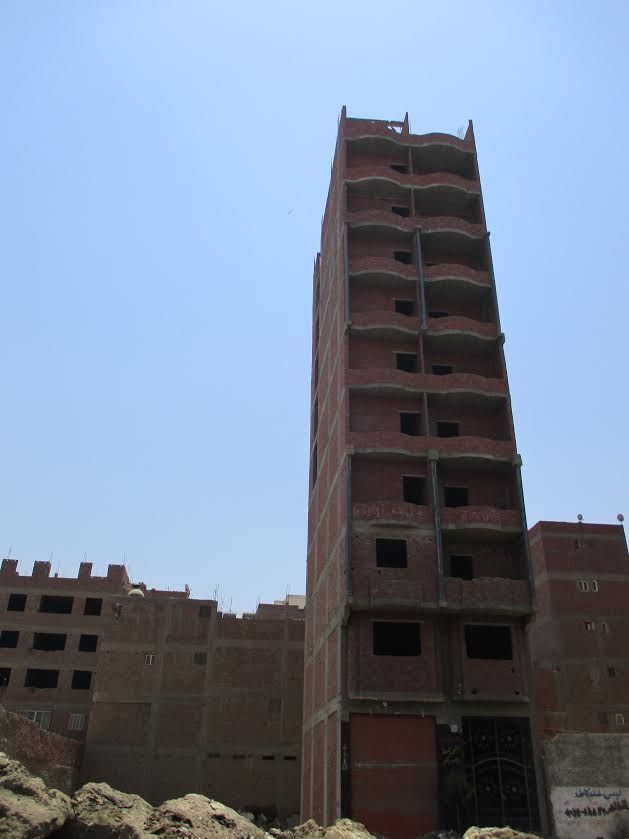In the village of Kafr on the western edge of Greater Cairo you can see this almost color-coded conflict.
It’s not a village in the traditional sense though. Brick high-rises stretch ten or 12 stories into the air between fields of alfalfa and leeks.
This is the most ubiquitous architecture of Egypt’s capital: unpainted red brick buildings that, when combined with their concrete beams and columns, look like Brutalist takes on plaid. Until the 1970s most bricks came from nearby, made from Nile silt, which also provided the rich topsoil that provided the foundation for agriculture in Egypt.
These brick buildings and farmland are now in direct competition with each other for space.
Most new construction in Egypt is on that agricultural land, despite a complete ban on the practice. Each year, 16,000 acres of agricultural land are built on, according to ‘10 Tooba’, an independent urbanism organization.
With only 2.75 per cent percent of Egypt’s land suitable for farming, and decreasing on a per capita basis, the land becomes more precious each day.
Kamel Sayyed moved to Kafr six years ago from another nearby village to take advantage of the cheaper rents. He rented an apartment then for 300 Egyptian pounds (EGP) a month, or £45 at the time.
Soon though, growth exploded. Building was long illegal and enforcement piecemeal, but when Hosni Mubarak was overthrown in 2011, a security vacuum started a blitz on illegal building.
Un-building a revolution
Sayyed says that almost immediately after Mubarak was forced from office, heavy machinery started digging foundations. Steel, concrete, and brick prices increased overnight. Egypt’s Informal Settlements Development Fund, a government organization, said there was a 10 to 20 per cent increase in three years.
South of Cairo, hundreds of smoke stacks extend to the horizon for as far as the eye can see. Each of these furnaces can churn out 250,000 red bricks everyday, feeding the city’s appetite for housing and development. This summer, only two or three were operating, as fuel prices were outpacing how much the factories could sell.
The government has encouraged development on desert land, in new satellite cities, and suburban-gated communities. One former Egyptian prime minister even referred to the escape from the Nile Valley as a matter of life and death.
These “new cities”, as they are known in Egypt, get 29.8 billion EGP in investment, while existing cities got 28.4 billion. New cities only host about two per cent of Egypt’s population, though.
For the 16,000 acres of rural land that’s built on each year, Shawkat says that only 4,000 acres of desert land are developed. Rural growth rates are doing something in Egypt that doesn’t happen in most of the Global South – outpacing urban growth. Still, Cairo is listed as the fastest growing city worldwide in terms of population.
“Part of building on agricultural land is because there is need,” says Yahia Shawkat of 10 Tooba. “There is a human, other part, which is speculation: land prices or property prices are really the only thing sort of rising in terms of value in Egypt. Urbanizing agricultural land is much, much more profitable than tilling it.”
With 52 per cent of farmers in the country being small farmers, the difference in profit presents a straightforward economic choice for many, for the time being.
Unconventional agrarian reforms
Building on agricultural land in Kafr has become an industry. Sitting in his office in Kafr, Hany Mahmouf Hafez, who works in construction, says that a single apartment can fetch at least £6,950, while a floor can cost between £900 and £1,400 to build. By comparison, an acre of land can bring in £90 or £140 a year. A woman picking out paint interrupted to say that it’s the best way to make money in the town.
Whether agricultural land will remain less profitable is up for debate.
Since Egypt floated its currency, agriculture seems more profitable, with food exports rising and imports declining.
For many, real estate was seen as a hedge against a declining currency. With the floatation, real estate might not be as good an investment in the short or medium term.
The proposed legislation is an outright ban on building on agricultural land, but that is far from the reality. The idea is to freeze the encroachment of cities into farmland and push it out into the desert, hence the massive investment into new cities.
But informal settlements that encroached onto farmland had what the new communities didn’t. They were near existing networks of water, sewage, and electricity, and even though they couldn’t be connected legally, a contractor could pay a bribe.
Contractors can pay £230 for an apartment to get power, or £900 for a full building to be connected to the grid. In order to prevent the huge drains on the power grid, the Egyptian government has put these informal settlements in a legal grey area by a partial legalization of unofficial power meters.
It’s a tricky problem. The outright ban isn’t working due to a lack of so-called “soft infrastructure”. The government has built roads, pipes, and power lines, but hasn’t provided enough schools, hospitals, and cultural activities to make living there make sense.
It’s difficult to think about how to allow rural growth, when ideally it would be minimized. Shawkat says there are ways to build in growth in a way that is sustainable.
“I’ll do it in a certain density and a certain way that would actually I would lose maybe ten acres, but I’m going to save 50.”
Whether the government plans to do that isn’t clear, and the long-term plan for food security is similarly hazy.
In the longer term, Egypt may need to learn to break with thousands of years of tradition, and start growing horizontally – east to west, rather than north to south along the Nile.
If it can’t, Egypt’s burgeoning cities will choke the fertile farmland of the Nile on which its heritage was built.
